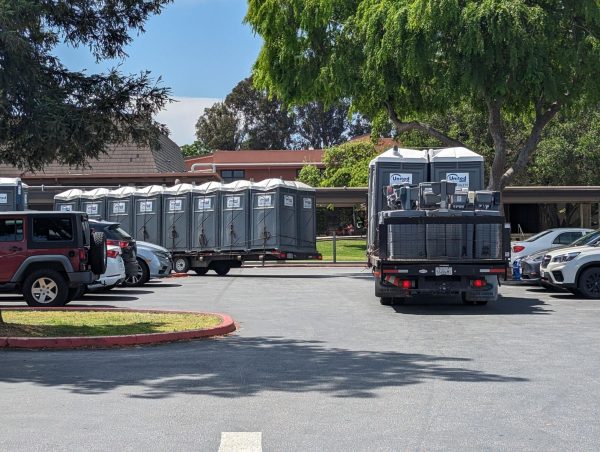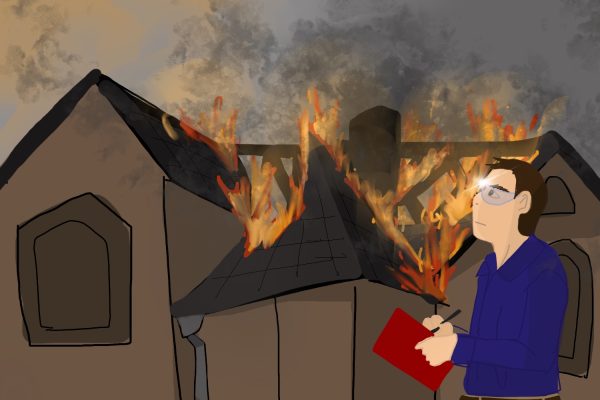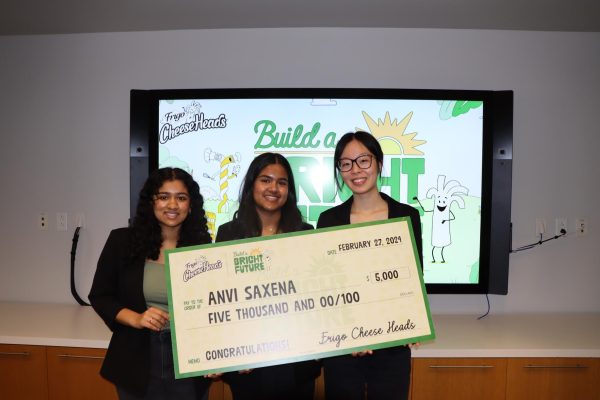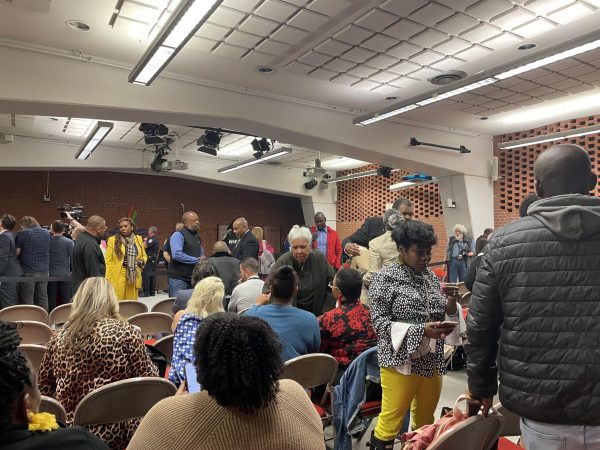Disproportionate discipline of Black students in SRVUSD threatens equity
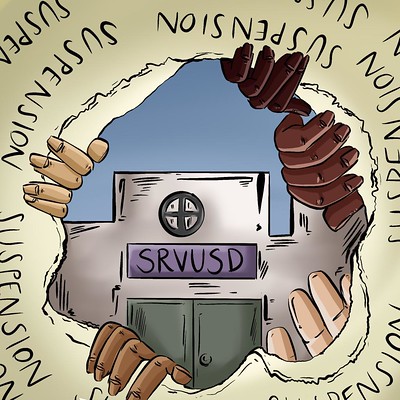
The disproportionate suspension of African American students in SRVUSD suggests potential inequity
September 21, 2020
“I have been called to the office four or five times for things that I didn’t do. One time I was even threatened with suspension and I had nothing to do with it [the infraction],” Dougherty Valley High School (DVHS) senior Ashraf Abdelmagid said, referring to his time at Gale Ranch Middle School (GRMS).
Abdelmagid’s experiences are not unique. Suspension rates among Black students at DVHS and other schools in the district have remained disproportionately high for years, raising concerns that disciplinary efforts by school administration are adversely impacting Black students.
Discrimination in Discipline
Data gathered from EdData, a database containing suspension records for schools in California, reveals disproportionately high suspension rates among Black students at some schools in the San Ramon Valley Unified School District (SRVUSD). Between 2014 and 2019, Black students constituted around 2-3% of the DVHS student population, but accounted for 12-17% of suspensions. During the 2018-2019 school year, 7.3% of Black students were suspended at DVHS, a figure that contrasts starkly with suspension rates of Hispanic/Latino, white and Asian students, at 2.1%, 1.8% and 1.2%, respectively.
This disparity is also evident at the middle school level. Despite Black students constituting just 3.7% of the student population at GRMS, they accounted for nearly 26% of GRMS’s suspensions in the 2018-2019 school year.
The disproportionate suspension of African-American students is a well-established issue in American education. An April 2019 Princeton University study analyzed a federal dataset of over 32 million students across 96,000 K-12 schools and revealed a startling association between racial bias and school discipline. Using data from the 2015-2016 school year, researchers concluded that racial discrimination “was especially high with suspensions”, with 13.5% of Black students receiving out-of-school suspensions compared to 3.5% of white students.
Student Experiences
Experiences such as Abdelmagid’s, where a Black student believes they have encountered unfair discipline by school administration, are not isolated instances.
DVHS junior Isaiah Hendrix reflects on a five-day suspension he received in the 2019-2020 school year for engaging in a physical altercation. He notes the differences in how he was treated compared to the other student in the fight — a white male.
“I got pulled out of class first. The vice principal came into my class, stood in the middle of the room and said ‘I need Isaiah Hendrix’ … I have anxiety and it is known on the school’s part, so there’s no need for that,” Hendrix explained. “The other student didn’t get pulled out— he went home. There was no meeting with him in person. It was just an email conversation with his mother.”
Despite Black students constituting just 3.7% of the student population at GRMS, they accounted for nearly 26% of GRMS’s suspensions in the 2018-2019 school year
Aside from what he views as biased treatment, Hendrix also noted a lack of communication surrounding his suspension. While he originally believed his suspension was only three days long, he later learned it was actually five.
“I got five days but no one told me it was five days until three days were up and I came back to school,” Hendrix said. “I never got an email. I never got mail, a phone call, a text message— nothing of the sort alluding to five days.”
Hendrix’s frustration with transparency also extended to understanding his sentence in the first place.
“Where did the five come from? There is no set explanation as to why I got five days. There is no set of rules I could look at to say, ‘okay, yes, I wasn’t wrong here, here and here’. There was none of that,” Hendrix noted.
The DVHS and GRMS administrations both cited student confidentiality and declined to comment regarding Hendrix’s and Abdelmagid’s experiences, respectively.
Student frustration with school discipline is evident across SRVUSD. At Monte Vista High School (MVHS), Sydney Wanguhu and Adanna Ogu, co-presidents of the MVHS Black Student Union, point out the differences in MVHS’s disciplinary treatment of white and Black students. They believe racial bias is prevalent in the school’s disciplinary procedures.
“The way our administration handles punishment does [vary] and has varied depending on race,” Ogu said.
Specifically, Ogu referenced a viral video that surfaced in December 2019. In it, a white female MVHS student called a Black man the n-word in sign language while chatting with him online. Ogu observed what she now considers was biased disciplinary treatment.
“It got to the point that [the female student] was convinced she was being suspended for her safety. That blew my mind and it shows how messed up this is,” Ogu said. “We have had students of color who have done something wrong but their punishment is handled way differently. ‘You’re gonna sit in this office and wait for your parents to pick you up’, whereas in her case, [it was] ‘Oh, you can finish your test and when you’re done, your mom can pick you up.’ It [the difference in disciplinary treatment] just shows, and it’s not okay.”
In response to the aforementioned incident, MVHS Principal Kevin Ahern released a letter to the community addressing the perpetrator’s behavior, which included: “The need is clear for a fundamental shift in mentality for a portion of our population and I pledge to lead this campus in making that shift.”
Hendrix noted a similar incident where students wrote threats containing the n-word on bathroom walls at his previous school, Pine Valley Middle School (PVMS).
“I went to the principal at the time and instead of doing something, they just erased it from the bathroom. And this happened multiple times,” Hendrix said. “Instead of the school jumping to my defense, they just erased it. It made me feel like I wasn’t being represented fairly, as well as [it was] not a really safe environment for me to learn.”
…systematic oppression puts Black students at greater risk of facing disciplinary action from school administrators
The principal referenced by Hendrix no longer works in the district and could not be contacted for comment.
Beyond racial bias, Tiana Day, a DVHS 2020 graduate and founder of Youth Advocates for Change — a nonprofit dedicated to supporting youth activism — presents another reason for disproportionate discipline rates. She argues that systematic oppression puts Black students at greater risk of facing disciplinary action from school administrators. Reflecting on her own experiences with sexual assault at a young age and growing up largely independent, Day explains that students with adverse childhood experiences (ACEs) — such as growing up in a one-parent household or experiencing abuse — are more likely to have negative interactions with authority figures, such as school administration.
The Center for Child Counseling notes that while ACEs are not limited to any single race, Black children are impacted by them at the highest rate (61%), followed by Hispanic children (50%).
Day experienced this growing up in San Ramon.
“It’s [taken] 15 years for me to be able to come out and talk about something that’s been so traumatic in my life and I am starting to realize that a lot of my friends have gone through the same experiences,” Day said. “Most of the Black students in this neighborhood have faced some type of hardship or some type of adverse childhood experience that will put them more at risk.”
Day believes that the occurrence of these traumatic experiences are often ignored, potentially precipitating the higher rates of suspension among Black students compared to other races.
“Teachers kept an eye on us [Black students] because we look ‘hard’ … when in reality, we are all having a major identity crisis,” Day recounts. “You are getting a group of kids who have been abused, discriminated and hurt in their lifetime … If you put all those kids in one situation, they are going to get into trouble.”
Black students in SRVUSD also note the long-term and damaging nature of disproportionate discipline.
“It’s a microcosm of the real world,” Wanguhu said. “Black people are being incriminated far more than they should be for minor offenses, so the suspension [rates] and imprisonment [rates] are mirror images.”
Past District Efforts to Combat Racism
Since 2013, SRVUSD has made efforts to increase equity across racial groups.
Chris George, former SRVUSD director of instructional services and district communications, explained that the district has collaborated with Dr. Sharroky Hollie, a professional development educator specializing in culturally responsive teaching/learning. George additionally pointed to a program adopted four years ago called Courageous Conversation. Facilitated by an external organization, Courageous Conversation trains teachers on how to hold emotional conversations about race and inequality.
However, the voluntary nature of these equity programs has dampened their effect.
While Courageous Conversation offers teachers training on how to address sensitive topics in the classroom, it does not directly address racially-biased discipline in the same way that restorative justice programs do
“We’ve hired outside organizations that have done professional development with some of our teachers, but the key word there is some and not all,” Ken Nelson, director of student services for SRVUSD, said. “Eventually, we will have to get to all — not just the ones that are just interested in social justice.”
For example, in the 2019-2020 school year, about only 90 out of over 1,500 teachers in SRVUSD attended Courageous Conversation sessions. However, Jon Campopiano, executive director of secondary education at SRVUSD, noted that the district is beginning to directly address this problem.
In July, every administrator in SRVUSD attended a district-led training featuring a keynote address delivered by the Courageous Conversation organization president. In the coming months, the district aims to expand this engagement.
While Courageous Conversation offers teachers training on how to address sensitive topics in the classroom, it does not directly address racially-biased discipline in the same way that restorative justice programs do.
According to Edutopia, a website centered around education-based stories, restorative justice programs focus on resolving conflicts with students through conversation and education, rather than punitive forms of discipline. For example, instead of suspending a student for bullying, a restorative justice program might hold discussions between the involved parties to resolve the issue through education.
Ashlee Guiterrez, the newly hired SRVUSD equity coordinator, argues that culturally-responsive training is a precursor to restorative justice work.
“Even though [Courageous Conversation] isn’t explicitly about restorative justice, they are setting up the work individuals need to do to be prepared to go into training[s] about restorative justice,” Guiterrez said. “If we can do the work to get people to see how important it is and buy into it needing to be a priority, then we can send people to the trainings for restorative justice.”
Nelson, reflecting on his past experiences as the principal of Hidden Hills Elementary School, assistant principal at California High School and teacher at John Swett High School in Crockett, CA, advocates against suspension. He believes that pursuing alternatives to suspension or expulsion — such as education or counseling — benefits students and administration alike.
“Suspensions didn’t change behavior, and in many cases it made students feel disconnected to their school — like people didn’t care about them,” Nelson said. “I came to the realization that there’s other things we can do to hold students accountable without keeping them from going to school.”
Building on this philosophy, SRVUSD offered support to schools with particularly concerning suspension rates. For example, Campopiano explained that the district recently hired three more social workers (one dedicated to the Dougherty Valley region) and two new mentors for students at Gale Ranch Middle School, as a part of their Trust Circle program, to increase student connectivity and lower discipline rates.
…pursuing alternatives to suspension or expulsion — such as education or counseling — benefits students and administration alike
However, Nelson cites parental support for punitive action as a barrier to shifting attitudes about discipline.
“Let’s say for example, a child was beat up by another student. Their [the child’s] parents want the [other student] expelled,” Nelson explained. “Well, let’s slow it down, talk about what happened and why. What can we do to make the situation better?”
Ultimately, the district acknowledges that there is much more they can do.
“No matter what we’ve done so far, it’s not enough and we’re going to continue to do more,” Nelson said.
School Perspective
At the school level, some administrations are also taking initiative.
Near the end of July, the DVHS administration analyzed survey results from teachers to identify staff needs for the upcoming year. Principal Evan Powell noted that “when we’re talking about the school climate and use of the n-word, we’re looking at a quarter of the staff that wants to learn more about how to address that”.
The DVHS administration plans to use upcoming professional development days to meet teacher needs and facilitate conversations based on these survey results. Powell explained that DVHS aims to foster more equity-related discussions between students and teachers. For example, DVHS held an open forum between students and English teachers in August in response to a June email campaign by students pointing out what they believed to be examples of racial bias in the English curriculum.
Additionally, at MVHS, Principal Kevin Ahern explained that MVHS’s Rising Black Scholars Program brings Black students together to talk about common problems they face and strengthen their BSU organization. Other efforts to increase awareness among staff include a faculty reading of the book “How To Be An Antiracist” by Ibram X. Kendi.
However, similar to district programs, these efforts are not discipline-specific, instead addressing bias in the classroom and curriculum.
Some schools in SRVUSD also feel limited by both district and internal school dynamics. Ahern stressed that the absence of a uniform procedure to train teachers entering the district makes it difficult to uphold equity standards consistently.
“What does onboarding look like when we bring in 200 new teachers across the district?” Ahern said. “Someone comes in and they’re not trying to understand these [equity] programs. Then all of a sudden it’s: ‘Alright, perform! Get your equity down, get your relationships down’…it’s like a fire hose.”
Specifically at MVHS, Ahern pointed out that staff demographics don’t reflect student demographics, creating barriers to shifts in mindset.
“This year we’re at 55% white [students] and 45% [non-white students], and I think by next year we will be 50/50. That’s something that teachers who’ve been [teaching] for a long time don’t quite get,” Ahern said. “Yet we continue to hire the same white, suburban person that may infatuate the same attitude that they held 20 years ago or 10 years ago.”
Among 122 administrators and teachers at MVHS, approximately 100 are white and only two are Black.
Ultimately, Ahern notes that without district backing, the success of site-specific initiatives are limited.
“We have to extend [school efforts] up to the district,” Ahern said. “These site teachers want to hear it from me, but they also want to hear it from the district.”
Future Steps for SRVUSD
On June 29, SRVUSD’s Board of Education released Resolution No. 95/19-20 Denouncing Racism, and Supporting Equity, Safety and Well-being of Black People, a statement promising that SRVUSD will increase efforts to reduce discrimination and biases within the classroom and the district at large. The resolution did not address discipline specifically.
In addition, SRVUSD hired Gutierrez, the district’s first ever equity coordinator, in June. However, at the end of the 2019-2020 school year, the district disbanded a team of three full-time Teachers on Special Assignment (TSAs) focused on increasing racial and gender equity in SRVUSD. This reassignment raises concerns that Gutierrez’s appointment inadequately replaces the prior, much larger, equity team.
Notably, Guiterrez expressed that she still intends to involve past TSA team members in her upcoming equity initiatives.
…staff demographics don’t reflect student demographics, creating barriers to shifts in mindset
Building on previous efforts of the TSA team, Gutierrez’s job is focused on addressing incidents of hate and microaggressions, as well as addressing general inequities in the district. Gutierrez hopes to use the lessons she learned as a principal in the West Contra Costa School District to improve SRVUSD’s approach to increasing equity. Although she acknowledges that a full restorative justice program could not feasibly be established within the next year, she aims to focus on “training principals and auditing our restorative practices to find out how much restorative training is needed and where” during the 2020-2021 school year.
Gutierrez also emphasizes her intent to work directly with students. “I want students to know that I hear them,” Gutierrez said.
She intends to implement a “Stop Hate” website that allows students to flag incidents of hate/racism, notify staff and create a response plan for the student harmed and engage in a restorative process that combines both consequence and education for the offender.
She is also an advocate for increasing funding for equity-related efforts.
“It’s going to be my charge over the next few years to hold a mirror back to the district and say, ‘If we are actually saying that equity is a goal, then here are the key places where we need to make changes’ … and then we have to put the money behind it,” Guiterrez said.
Despite district promises to expand equity-related efforts, budgets set as of July 24 suggest otherwise.
Guiterrez stated that the district plans to spend $18,000 on furthering Courageous Conversation training for district staff. In addition, around $10,000-$15,000 has been set aside for supporting equity-related professional development, such as enrolling teachers in training webinars and providing additional curriculum materials. In total, this puts the 2020-21 equity budget at $28,000-$33,000.
However, this is markedly lower than last year. Campopiano said the district spent $35,000 on Courageous Conversation and $100,000 on all equity efforts. The $35,000 effort covered training for around 90 teachers over six sessions ($6,000 each). This raises questions on how the district aims to meet their goal of training all staff, roughly 1,500 teachers, over the next two years, with this year’s Courageous Conversation budget being nearly half of last year.
When asked to explain this discrepancy, Campopiano didn’t respond to requests for comment.
Student Goals for Reform
Black students in SRVUSD have also voiced their own visions for reform.
Abdelmagid cites ignorance as a large reason for racial bias among students and what he believes has been a lack of action.
“They [students] think that since [DVHS] is not a white majority school, it can’t be racist,” Abdelmagid explained.
To mitigate this, Waghnu, Ogu and Abdelmagid all believe that discussing racial issues in the classroom can spark necessary discussions and reduce both overt and subtle biases.
Additionally, with recent experience organizing protests for the Black Lives Matter movement in San Ramon, Sacramento and San Francisco, Day hopes to partner with SRVUSD to amplify youth voices.
“What I wanted to do was host an open mic event and it would just be a big conversation,” Day explained. “We could share our experiences as students with the community.”
Ultimately, Day is hopeful for progress. She believes that youth in SRVUSD must become more vocal to create reform.
“I don’t see any adults in our district being hostile or hateful in any way; they all really want to help, but the problem is that there are no youth talking about it,” Day said. “Once you start speaking up, you realize you have the power to do so much and it feels like you are finally getting heard.”
This story was originally published on Wildcat Tribune on September 18, 2020.
















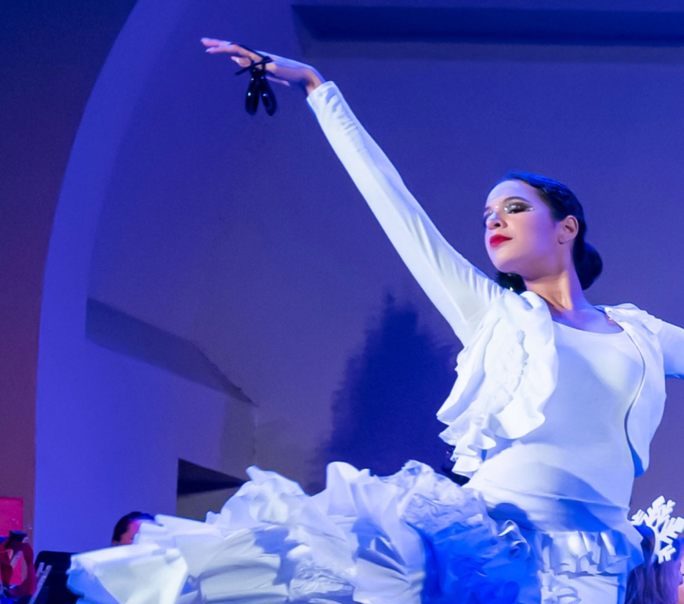














![IN THE SPOTLIGHT: Junior Zalie Mann performs “I Love to Cry at Weddings,” an ensemble piece from the fall musical Sweet Charity, to prospective students during the Fine Arts Showcase on Wednesday, Nov. 8. The showcase is a compilation of performances and demonstrations from each fine arts strand offered at McCallum. This show is put on so that prospective students can see if they are interested in joining an academy or major.
Sweet Charity originally ran the weekends of Sept. 28 and Oct. 8, but made a comeback for the Fine Arts Showcase.
“[Being at the front in the spotlight] is my favorite part of the whole dance, so I was super happy to be on stage performing and smiling at the audience,” Mann said.
Mann performed in both the musical theatre performance and dance excerpt “Ethereal,” a contemporary piece choreographed by the new dance director Terrance Carson, in the showcase. With also being a dance ambassador, Mann got to talk about what MAC dance is, her experience and answer any questions the aspiring arts majors and their parents may have.
Caption by Maya Tackett.](https://bestofsno.com/wp-content/uploads/2024/02/53321803427_47cd17fe70_o-1-1200x800.jpg)
![SPREADING THE JOY: Sophomore Chim Becker poses with sophomores Cozbi Sims and Lou Davidson while manning a table at the Hispanic Heritage treat day during lunch of Sept 28. Becker is a part of the students of color alliance, who put together the activity to raise money for their club.
“It [the stand] was really fun because McCallum has a lot of latino kids,” Becker said. “And I think it was nice that I could share the stuff that I usually just have at home with people who have never tried it before.”
Becker recognizes the importance of celebrating Hispanic heritage at Mac.
“I think its important to celebrate,” Becker said. “Because our culture is awesome and super cool, and everybody should be able to learn about other cultures of the world.”
Caption by JoJo Barnard.](https://bestofsno.com/wp-content/uploads/2024/01/53221601352_4127a81c41_o-1200x675.jpg)





